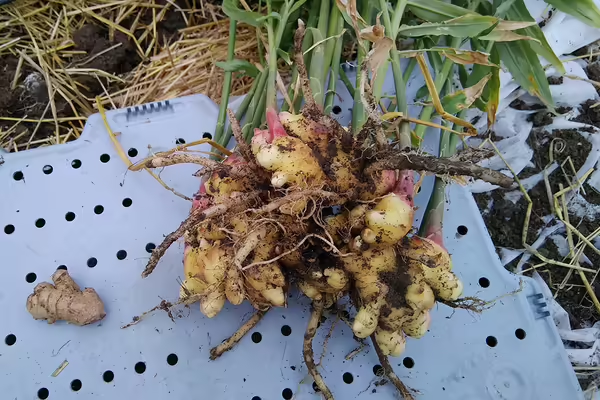
URBANA, Ill. — Growing fresh vegetables, fruits, and herbs in the backyard can seem like a lot of work, but at the end of the season, the bountiful, tasty harvest is worth it. The International Herb Association named ginger (Zingiber officinale) the 2023 “Herb of the Year”. This is one herb that is not typically grown in Illinois gardens and is often easier to buy at the grocery store. However, ginger can be grown successfully in Illinois home gardens with a little extra planning and care.
The gnarly, tan rhizome, or underground stem, of ginger has a strong, spicy flavor and is grown for a variety of culinary uses, including baked goods, teas, and soups. When used fresh, ginger is considered a culinary herb. When ground or powdered, it is recognized as a spice.
Ginger that is commercially produced for culinary use is grown in tropical climates, which offers the plant 8 to 10 months of growth before the harvest of the mature rhizome. It will not survive outdoors in temperatures below 30 °F, which makes it an annual plant in Illinois.
Researchers with University of Illinois Extension and Western Illinois University are currently exploring how to commercially produce ginger in Illinois to give specialty crop growers a new high-value product that can grow in high tunnels. Find out more about the project at go.illinois.edu/GingerCrop.
To increase the length of growing time by a few months and allow adequate time for the rhizome to mature, start ginger plants indoors in February or March. Purchase sets, or small sections of the certified disease-free rhizome for planting, from local garden centers or nurseries, or online seed companies. Ginger roots found in the grocery store receive an inhibitor treatment to avoid sprouting and are not certified disease free.
Plant ginger in at least a 15” diameter container to move outdoors when temperatures are consistently between 70- and 80°F. When starting rhizomes in containers, the top of the rhizomes should barely be covered with soil to avoid rot. Also, allow space at the top of the container to add more soil as the rhizome pushes up. Detailed planting directions can be found online to ensure a successful crop.
Ginger will grow in part-shade to full sun and will not tolerate overly wet, waterlogged soils or completely drying out. Brown leaf tips are an indicator the plant either needs more water or it is receiving too much sunlight. Yellowing foliage is a sign that supplemental fertilization is needed.
In addition to growing for culinary use, ginger also makes a beautiful ornamental plant in any garden. With a clump-forming habit, reaching 3 feet tall, ginger’s strappy, bright green foliage adds a tropical flair to a garden landscape or patio container.
Baby ginger, or small sections of the rhizome, can be harvested after four months of growth. These immature sections have the same taste but are not as fibrous since they lack the tough outer skin of a mature rhizome and can get damaged easily. They can be stored in a freezer for several months to enjoy later.
To harvest mature sections, bring them inside before temperatures drop below freezing and wait until the leaves turn brown and dry out around November, and then carefully dig the rhizome from the soil. If planning to overwinter the plants, move the container indoors before freezing temperatures. Once inside, the plant will go dormant for the winter, losing all the foliage until temperatures warm in spring.
As the International Herb Association’s Herb of the Year, ginger is both beautiful in the garden and valuable in the kitchen. Also, consider planting past winners in your garden: violet (Viola), parsley (Petroselinum), anise hyssop (Agastache ssp.), coriander/cilantro (Coriandrum sativum), and savory (Saturea ssp.)
For more research-based information on fruit and vegetable gardening, contact a local Illinois Extension expert at go.illinois.edu/ExtensionOffice.
WRITER: Brittnay Haag is a Horticulture Educator with University of Illinois Extension, serving Livingston, McLean, and Woodford counties. Gardeners Corner is a quarterly newsletter from gardening experts around the state. Each issue highlights best practices that will make your houseplants, landscape, or garden shine in any season. Join the Gardener’s Corner email list at go.illinois.edu/GCsubscribe for direct access to timely tips.
PHOTO ACCESS: The photo in this article is available to download for media use. Photo by Chris Enroth.
Illinois Extension leads public outreach for University of Illinois by translating research into action plans that allow Illinois families, businesses, and community leaders to solve problems, make informed decisions, and adapt to changes and opportunities. Illinois Extension is part of the University of Illinois Urbana-Champaign College of Agricultural, Consumer and Environmental Sciences.